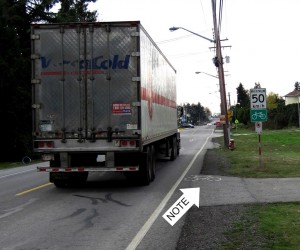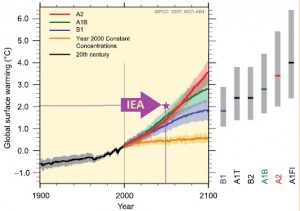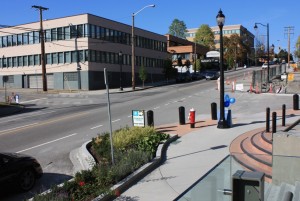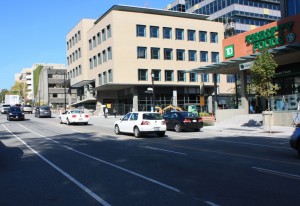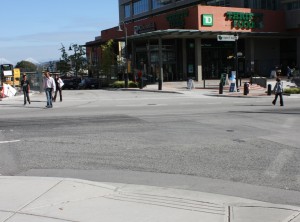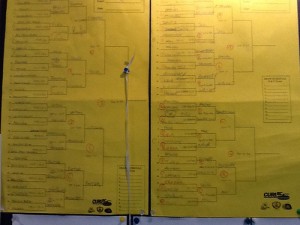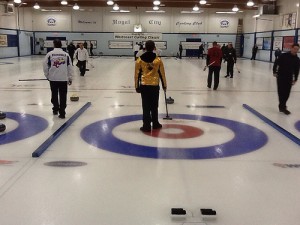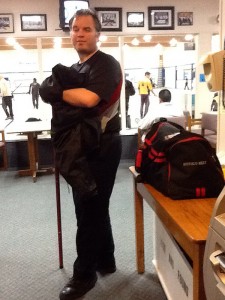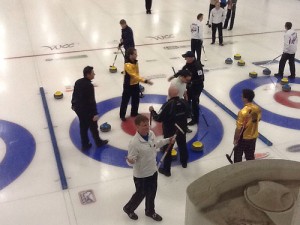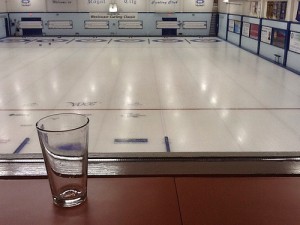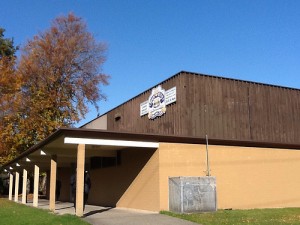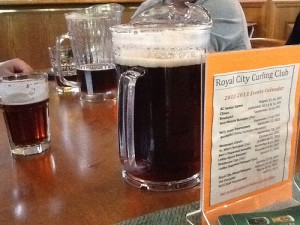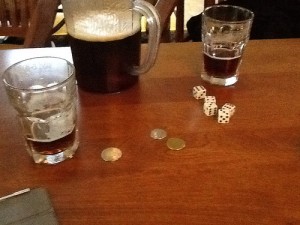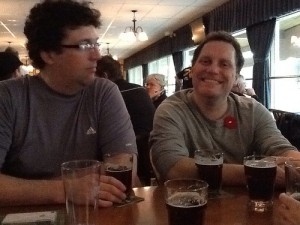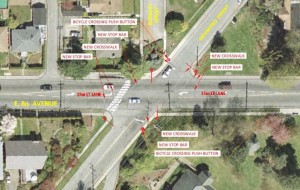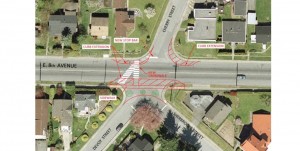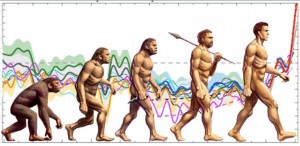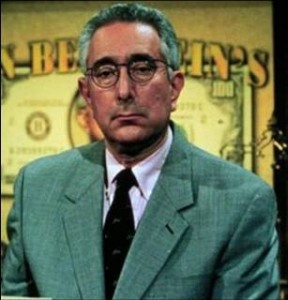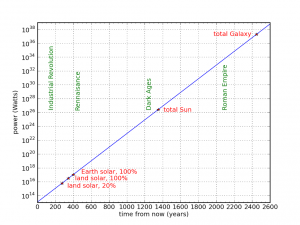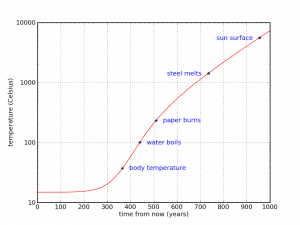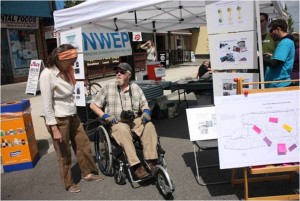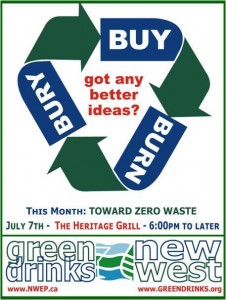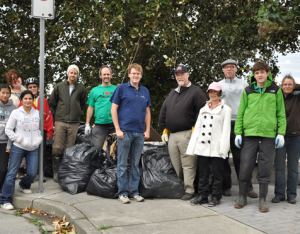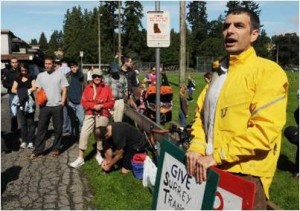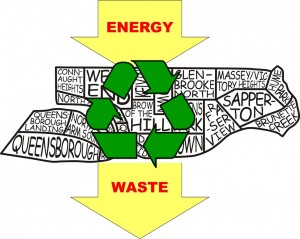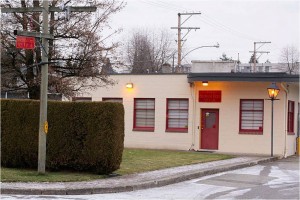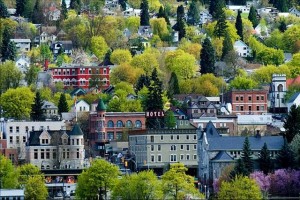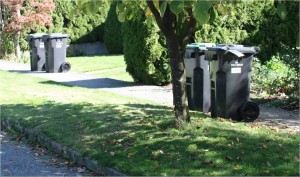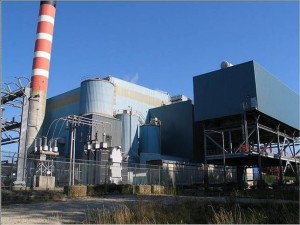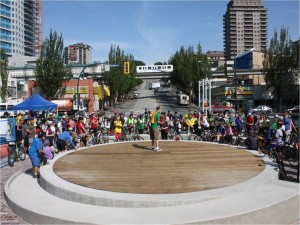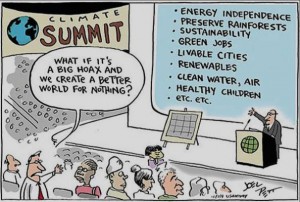I offer, without comment (but one small annotation):
All the Good News that Fits
Proving that there are two ways to look at any story, it has been interesting to watch the news coming out of this recent report by the International Energy Agency.
The story on the CBC, that bastion of left-wing thought, was positively glowing for the future of oil and gas. The US will be the world’s largest hydrocarbon producer by 2020, and completely energy independent by 2035. The only problem they forsee for Canada is that we will be producing so much oil and gas in Canada in the next decade that we will outstrip our ability to burn it or export it.
Few stories, however, talked about the other half of the IEA report. I pick a few relevant quotes from the Executive summary:
“Taking all new developments and policies into account, the world is still failing to put the global energy system onto a more sustainable path. Fossil fuels remain dominant in the global energy mix, supported by subsidies that amounted to $523 billion in 2011, up almost 30% on 2010 and six times more than subsidies to renewables.”
So we are pulling too much carbon out of the ground, too fast, and government policies are specifically designed to mainline this unattainable status quo, not working to fix the inherent problem with this.
What inherent problem? How about these quotes:
“Successive editions of this report have shown that the climate goal of limiting warming to 2 °C is becoming more difficult and more costly with each year that passes. No more than one-third of proven reserves of fossil fuels can be consumed prior to 2050 if the world is to achieve the 2 °C goal. Emissions correspond to a long-term average global temperature increase of 3.6 °C.”
Now compare this to the most “alarmist” of IPCC predictions, and you can see that the International Energy Agency is predicting something like twice the warming than the average of the IPCC models over the next 4 decades. Yet this part didn’t even make the news.
We can pull more carbon out of the ground that we know what to do with, and we know doing that will cause unintented catastrophe. Its like we have some kind of Obsessive Compulsive Oil Extraction Disorder.
Note – we don’t have to leave that carbon in the ground forever. The climate change thing isn’t about how much gas, oil and coal we burn, it is about the rate at which we burn it. To avoid catastrophe, we don’t need to stop using hydrocarbons, we need to slow down until the biosphere can catch up, or until we invent some sort of practical and realistic sequestration technology (which the IEA notes we are not actually inventing anywhere near fast enough). If we leave it in the ground, it will always be there. It is already so valuable for everything from plastic to chemicals to medicine that it is frankly baffling that we still waste so much of it on simple combustion – but that’s another whinge.
So we have a choice- we can rush to exploit the Bitumen Sands faster than we can burn and export it, or we can do it slowly, keep as much in the ground as long as possible, and extract more value out of every tonne of carbon extracted.
If we take the fast-and-cheap route, we will run out faster, make less per tonne, and threaten the most expensive infrastructure we have – our coastal cities (see New York and Venice). Not to mention the homes of hundreds of millions of people, and entire marginal ecosystems. Then we will leave the future generation the problem of abandoning those cities or investing massively in energy-intensive plans to save them- after we have already spent all of the easy money and burned off all of their cheap energy.
Try explaining that to your children, who I assume you hope will be alive in 2050, even after you are in the ground. That is why Anthropogenic Global Warming isn’t a science problem or a political problem, it is an ethical problem.
Thrifty Pedestrians
I think I love Thrifty Foods.
All of the sudden there are a lot of grocery options in New Westminster. No less than three Safeways, all of them of the recent-design mega-big variety; a Save-On-Foods of the slightly-too-compact urban style, an IGA that is seemingly a little crowded out and increasingly out of the way, along with Donald’s at the River Market and other smaller boutique-type options. Notably, Thrifty’s is the only Grocery spot in Sapperton (7-11 excepted, of course). The only grocery deadzone appears to be Queensborough (although, someone might tell me they have groceries in Wal-Mart: I’ll never know).
I have nothing against Safeway, and think their willingness to put a storefront on a Transit mall is a bold move worthy of praise, but I generally find their prices a little high, and their approach a little too “corporate”. I am “personally” thanked by checkers, with few of them taking to time to look at my actual name before saying, blankly, “Thank You Mr. Moose” (A Safeway Card under the name Space Moose was a bit of culture-jamming I engaged in a few years back. Note, if William Jefferson Clinton wins a big prize in one of those Save-on-More Card contests, I’m not sure how hard it will be to collect. But it makes my junk mail more interesting).
Alas, we tend to buy our groceries within walking distance, which means the Save-on-Foods with its less-than-optimal aisle widths, it’s strange practice of labelling all of its fruit as multi-origin (“Apples: USA/Canada”), and its distinct paucity of humans working the checkouts.
Aside: Look, the automatic checkout is never faster or more convenient for the shopper than having a person check your food, unless there are not enough checkout staff. If you think I can enter the code for apples (fuji or ambrosia? ) or lettuce (green leaf or romaine?), operate a bar-code scanner, and fill a grocery bag faster or more efficiently than someone who does it 8 hours a day, you are crazy. Essentially, Jimmy Pattison is getting me to do the work of his staff – because he doesn’t have to pay me. . –end rant
I would be remiss to also point out that Ms.NWimby does most of the grocery shopping for the household. This is mostly because of her advanced ability to shop ahead a week (instead of my tendency to buy for today and tomorrow), but also because she found me no fun to shop with, as I am generally an ornery retail customer (having grown up working in retail and having high customer-service expectations) and not much fun to be around when assaulted by bad retail decisions.
For smaller “just-pick-up-a-few-things” trips, I tend to run up to the Uptown Market on 6th – a small shop that always impresses me with their variety, quality, and customer service. In the summer, the drive to buy local often leads us to Hop-On Farms on Marine Drive- for garden-fresh produce. Weekly trips to the Royal City Farmers Market just about rounds out or grocery experience.
So I have only been in Thrifty’s a few times, but I might need to start about making it the usual – maybe I’ll buy a cargo bike, and take some of the load off of Ms.NWimby. The thing about Thrifty’s is that it is everything I like: they have a good mix of basic groceries and higher-end fancy stuff. They have a nice produce section, and I know what is being grown domestically. The space itself is expansive and comfortable, the lighting is soft and organic. I’m not assaulted by offers to save more by buying more than I need. And when I am done shopping, an actual human being helps ring up my purchase. In fact, there are actual human beings working throughout the store – unobtrusive but helpful. I just wish it was walking distance.
I hope (and expect) that Thrifty’s will prosper in Sapperton, even though it is currently neigh-impossible for many Sapperton folks to walk there. And here is where my second rant of the blog post begins:
The City of New Westminster has, as I have noted many times before, a Pedestrian Charter. The Charter says that the City puts a high value on pedestrian safety and access, and that walking will be prioritized over other forms of transportation within the community.
Meanwhile, for the entire time Thrifty’s has been open, the sidewalk leading north from Thrifty’s up Columbia Street has been closed to pedestrians, with no accommodation made for safe passage of those on foot. People walking down Columbia from Royal Columbian Hospital or any other business in Sapperton (not to mention about 70% of the residences in Sapperton), need to cross Columbia for a block, then cross back at Simpson Street to get to Thrifty’s.
This might be a minor nuisance, except there is no safe crosswalk at Simpson Street! Right where Thrifty’s entrance/exit abuts the “closed” sidewalk, there is nary a street sign, paint on the ground, pedestrian sign, flashing light on anything to facilitate the safe crossing of the street. I stood there on a recent Sunday afternoon, and watched as people (young, old, single, groups, adults and children) walked out of the store, and made the choice between weaving through the “no pedestrian zone” barriers and tape (there was no active construction happening) or braving an unmarked crossing of a busy street while laden with groceries. Never did I see a car stop to let people cross. Even with light Sunday traffic, it was a terrible situation.
Problem is, it has been like this for months – has no-one in the City recognized this problem? I know I brought it to the attention to someone on staff two months ago, but nothing seems to have been done. Of course, I shouldn’t have to bring it to the attention of staff: when the sidewalk closure was approved to facilitate ongoing construction on the Brewery District site, was no though paid to how people were going to get past the site, to the one significant pedestrian destination south of the site? That is what a community with a Pedestrian Charter should look like. A crosswalk would take $100 worth of paint, the contractor building the new building should have to pay for it.
Or, for an example of what should have been done, walk up to Uptown Property Group’s development on 6th Ave and 5th Street and look at the hoarding arrangement there. There are concrete blocks and scaffolding cover to protect pedestrians from construction and from passing cars during construction. The point is, pedestrians are accommodated as important road users, and are not forced to cross the road unsafely (although, I note, there are marked crosswalks at every intersection near there to improve safety there as well). What’s good for Uptown should be good for Sapperton.
I just wish there was a Thrifty’s Uptown.
NextUP and Risk
This weekend, when not on the curling ice or licking my wounds in the lounge after, I was kicking up my heels at the NextUP event: Dancing Dweeb; Old and Tweed; Almost Seventy.
It was a fun evening, recognizing the emerging leaders of the “new” New Westminster, as selected by the Newsleader. My impression from the organizers is that the City does a very good job recognizing its tradition and history, and its long-serving community members, but we rarely acknowledge the up-and-coming generation of potential leaders. As a Citizen-of-the-Year nominee said to me last week (and I paraphrase): “It is nice someone is recognizing those with positive viewpoints and optimism, instead of always hearing from the City’s boo-birds!”
The result is an interesting collection of New Westminster residents: from an internationally-recognized author to a Sportscaster who takes time from reporting on the Olympics to coach the local High School football team, to some of the City’s biggest cheerleaders. There are volunteers, business owners, innovative thinkers, and other community-builders.
And one random blogovator.
The guest speaker was the most inspiring part of the event for me. Mark Brand of the Save-on-Meats social empire. If you don’t know his story, here is a story about his unique approach to community-based business. Or watch this bank commercial to see another look at his story:
I loved Mark’s talk, because he gave us just enough of his stunningly diverse upbringing to let us see into his motivations in building community, and because it always felt he was talking from the heart (I also admired that he wasn’t afraid to drop a well-applied f-bomb in front of the Acting Mayor!). However, Mark’s talk mostly got me thinking about risk, how different people measure the reward part of the risk-reward equation, and how we measure success.
The NextUP group included people like me, who do our thing (if you consider whinging on-line a “thing”), and people like Tej Kainth who do lots of things all the time, all for the building of community. But I have comfortable job and a comfortable life: not rich, but not worried about money, because I can afford to eat and I don’t spend much. I have the luxury of volunteer time and energy and ability (and recognize those are luxuries many cannot afford). But I don’t really take risks in my life. I rarely have. So coming out of the NextUP event, I wanted to acknowledge those people in our City who have taken and are taking risks.
I think about NextUP honouree Paul Minhas – who took a risk on Columbia Street almost a decade ago, when few others were forecasting the resurgence of the Golden Mile. He decided he could run a place that had good food, a friendly atmosphere, an artistic setting, and (here is the magic) live music every night! More than a jazz club, the Heritage Grill hosts open mic nights, poetry, LGBT events, bluegrass, rock-a-billy, flamenco, mariachi – you just don’t know what you might hear one night at the Heritage. But it is always live, and it is close-up and intimate, so you can have a beer with the artist between sets. I have met much of my New West Social Network indirectly through Paul, as his club was willing to host Green Drinks – an event where he surely sold more connections and conversations than actual drinks (aside: look for a return of Green Drinks New West edition in 2013). The point is, Paul was right, and his risk has paid off for the neighbourhood where there are now a half-dozen nice spots to get a beer (but still only one dedicated live-music venue!)
Or NextUP honouree Mark Shieh, who saw the empty husk of the Westminster Quay – almost derelict after 20 years of failure to find momentum – and took a risk. He risked his energy, his credit, his money. A Mechanical Engineer opening and running some sort of new-style urban shopping mall: Crazy. Mark is still taking that risk, as tenants are arriving, some prospering, some likely just waiting and hoping that their own risk will pay off. But look at the River Market on any given Saturday, and you can see that there is something being built here from which we are all benefiting.
I had friends visiting from Calgary/Toronto last weekend, and was proud to take them down to the Market for brunch, and show them the optimism of the Market, the beauty of the location, and the quality of the food! I didn’t feel like I had to take out-of-town guests down to Vancouver to “show off” my community. Between the River Market, the Pier Park, and Antique Alley, we had a great afternoon in New West.
What the two Marks and Paul have in common is that they took the risk, for which many more if us are receiving the reward. I think especially of Mark Brand, who seems to have taken a series of huge leaps, run several businesses, and seemingly never made much money. A guy with that kind of entrepreneurial spirit and relentless drive could be driving a Ferrari and choosing what shade of white shag would best suit his yacht. Instead, he is building a social enterprise – building a community. For his own benefit surely (we build the world we want to live in), but also for the benefit of untold future entrepreneurs using his “incubator” kitchen, and for the neighbours who for whatever reason haven’t had the opportunity to find success in our society.
I admire these risk-takers, from someone not nearly as brave. But you got me thinking: maybe its time for me to take a risk or two. There are a few things I would like to see happen in this City that will take a more hands-on approach. Maybe it’s time for me to take a chance.
Blogging the Dogwood – a Sunday in heck.
Sunday is the tough day in any bonspiel. There are a few teams who only have to play twice (assuming they win), but for the teams down in the “C” event, it is a long road. Do the math: 16 teams are in the “C” at dinner time on Sunday, and they need to be whittled down to 1 by Sunday afternoon – that’s four 2-hour games in less than 24 hours for the finalists.
Fortunately for team Johnstone, that is not a road we need to travel. Knocked out of the “C” in a tough loss to Doug Meager. As reported by the guy who playes third for Team Johnstone (but was skipping this game):
We played very well, high shooting percentage by everyone, but not a terribly exciting game. We blanked ends 1 and 2, then were forced to take 1 in the 3rd. They scored 1 in the fourth, and stole 1 in the fifth. We blanked the next two to keep hammer coming home. We couldn’t quite bury my first draw in 8, and they took it out, forcing a draw anywhere into the 8-foot to tie it. However, we came up short of the rings. The rock wasn’t swept except for the last ten feet, so it’s tempting to blame the sweepers, but the rock hit a flat spot again, turned pretty sharply and lost all its speed at the very end.
A 3-1 score, with four blanked ends is pretty much the definition of “not terribly exciting”. Disappointing, but I have to mention that Royal City veteran Doug Meager, unassuming with his slip-on slider, winter mitts and deep-tuck toe slide, has been to the freaking Brier, back when 3-1 scores were commonplace in high-level curling. No shame in losing a tough defensive battle to him! Bonus is that this freed up the members of Team Johnstone to enjoy the Saturday evening pursuits without fear of an early game Sunday.
So we slept in, and came down to support the local teams suffering the long-road. Like the infamous Meat Brothers: a combination curling club, social phenomenon, and high volume double entendre factory, with half of them still shaking it up the “B” event:
Blogging the Dogwood – Saturday
Waking with a bit of fuzziness from barley flu, it seems inappropriate to go inside on a sunny day like this.
We play at noon against team Johnson. Other than the distinct paucity of a name-ending “e”, I don’t know much about them. Apparently, they come out of the Richmond club, but they won their first game against Bryan Miki of the Royal City, and Bryan Miki won the world championships in the year 2000. Yes, he was on the team that won the Tankard, won the Brier, and won the World freaking Championships. That’s the way it is at The Royal City Club: one day you are playing against normal humans, the next day you are playing against World Champions. At least Johnson beat him, which means we dodged that bullet.
Anyway, we have home-ice advantage over Johnson, and that might be an advantage this weekend. The ice was a little finicky in the first game, there were what seemed like a few “flat spots” where the pebble had broken down, causing two rocks traveling down the same path to do two very different things. This is not a good thing for skips. It is like putting in golf after the neighbour’s kid mowed the green with a dull lawnmower. Or playing darts in a hurricane (to continue the Scottish Sport metaphors). So it is home ice and luck versus skill and intimidation (they have matching uniforms!). We will need a beer first.
(a few ends of curling later:)
Yeah. So apparently shot-making actually trumps home-ice advantage. One of the great parts about Curling is that you don’t have to belabour a loss. At some point, you can just look at the other skip and admit you are beat. 7 points down already half way through? You just shake hands with the other team, and you all drink beer. Imagine if football, soccer, hockey, any sport ended like that. Five point lead with 2 minutes left in a Hockey game? Just shake and and go drink beer. It is only civilized.
So six ends in, we had enough, there was no coming back, we shook hands, and all headed upstairs for part 2.
But don’t give up to early, here is a 2:30 game that went to the extra end: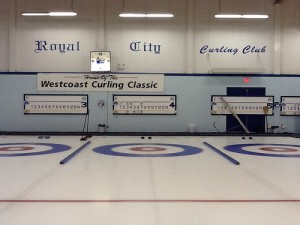
Curling score boards are sometimes hard to read for baseball fans, but remember, the game was invented by Scots, anything to reduce costs: the middle line is the score, the top and bottom are the ends (this way, you only have to print 8 “end” panels instead of dozens of “score” panels). On the board above, blue scored one in the 1st end, stole two in the 2nd end, stole one in the 3rd end, and stole three in the 4th. They were up 7-0 after 4, a shaking of hands was possible at this point. Instead, the yellow team then scored three in the 5th end, stole two in the 6th, one more in the 7th, and one in the 8th. They had to play an extra end to break the tie. God I love this game.
I also love that the winning team had a healthy respect for tradition, even moth-infested tradition.
As for team Johnstone, we are down the “C” event, every game is an elimination from here on in. We have a dinner tonight, then back on the ice: a curlers work is never done. We have a couple of hours to kill, though, so the liars’ dice come out.
Blogging the Dogwood – Friday
Those that know me know I am a member of the Royal City Curling Club, the best curling club in the Lower Mainland and a hidden gem of New Westminster. Most of you, however, have probably never been inside the club on East 6th. I can’t tell you the number of people who have lived in New West for years, even frequent the Canada Games Pool, and have probably driven or walked by the club dozens of times, but tell me they just didn’t notice the big brown building with all the shouting inside.
This weekend, I am going to be inside the club a lot, so I figured I would blog it out, from inside. Take you into the world of a curling club that is just like any of hundreds of similar clubs across Canada, on a bonspiel weekend. I can’t tell you everything, as every bonspiel is a little like Vegas – there are things that happen in a Curling Club during a ‘spiel that stay at the ‘spiel.
This weekend is the Dogwood Bonspiel. This is an annual Men’s bonspiel. It is open to members of the club and non-members, males of any age. It is generally a social ‘spiel as opposed to a more competitive “cash spiel” or the competitive spiels used to determine who represents the region at Provincials, or BC at the Brier. The Dogwood is more about the good times, friendly competition, and the liberal application of beer to any problems that may crop up.
I should note, as a Scot, that the Scottish have invented three sports: Curling, Golf, and Darts. All three have bars attached.
The Dogwood is a guaranteed three-game affair. There are three events, and all 32 teams start in the ‘A’ event. Lose your first game, you are down to the ‘B’; lose your second game, you are down to the ‘C’; every game after that is an elimination game. This, along with dinner drinks and dancing on Saturday night, is all you need to know about the bonspiel.
Tonight we play Jared Wannamaker from the Gibsons Club. He is probably the best player on the Sunshine Coast. I’m playing with two brothers who I have played with for years (actually, I played with them last time I played Wannamaker, at the Pacific Club Challenge about a decade ago…), and a guy who volunteers on the RCCC board with me. We are in it for the beer, but might win a game or two.
Game is a tipsy-turvy affair. We steal two points in the first (“stealing” means they had last rock advantage, but we scored) and they blanked the second (“blank is when they have a chance to score one, but choose to instead score zero, to hold onto last rock advantage for the next end). It didn’t do them much good, as we stole two more in the third, and one more in the fourth. 5-0, game is pretty much over. Then they score two, make a miracle shot to steal third, and we are tied again. The curling gods giveth, they taketh away. My last shot of the last end is a team effort: Third calls the line perfectly, two sweepers read the weight perfectly, and they have to throw a miracle shot to win… But they already used up their miracle this game. We are still in the ‘A’.
Then we drank some beers. Oh, and I had to get a picture of me with Dale Hockley. This is one of the magic parts of curling. Dale was an RCMP officer in Castlegar when I was growing up, and he was far and away the best curler in the club. It helps he was also a hell of a good cop – the kind of RCMP officer that a troublemaking teenager like me can talk to and respect. Hell of a nice guy, great curler, good cop – a perfect gentleman. Of course, I dont live in Castlegar anymore, nor does Dale. But 25 years later, we can meet at a cruling rink, have a social beer, and I can get a picture to show my Parents (who have forsaken curling for more tropical retirement pursuits) that Dale is doing well, still curling, and still a perfect gentleman.
OK, next game tomorrow at noon, and it’s my round.
In which I once was wrong.
Nothing worse that being criticized by someone who is right…
I just received a comment from someone on a post I wrote a few months ago, and it deserves more attention than being buried as a comment in a months-old post (I also like his style: mixing compliment with insult so subtley, that I somehow feel better about being called an idiot). So read the post here, and here is the comment from “D Calen Knauf” in its entirety:
Interesting view you have, not as negative as I had hoped. Naive and selfish negativity towards skateboarding is much more fun to debase. I have several issues with this article and with your proposals to improve the state of skateboarding at pier park. Right off the bat you propose more skateparks. That is like saying “god I hate it when runners wizz by me when I’m walking in the morning, clearly there aren’t enough running tracks and ovals. Let’s build some more!” that is not solving anyone’s problem. The reason people are skateboarding places other than skateparks is because that is what skateboarding is all about. Maybe you grew up in a community of people that really appreciate structure, rules and segregation. There are many other groups of people that don’t find that type of activity engaging or fun and prefer an activity with creative freedom and a sense of personal challenge. Skateboarding started in the street and will always be there, just like walking, running, biking…
As far as damages go, the damage you see now is as far as the damage will go. It’s concrete, not stucco, it gets a little dirty, the edge rounds off and that’s about it. Roads get tire marks on them sidewalks get scuffed and chipped from use, why do you all of a sudden feel that these edges are any different. It’s a patina on the city, like the green oxidization on the Vancouver hotel roof. You mention that the park was so nice with kids laughing and people playing guitar… well personally I don’t have kids and don’t appreciate the sound of their laughter the same way you do. Same goes for the guitar, or basketball, or… the difference between me and you is that I–like you mention– realize that I am living in a society, and realize that what I like doesn’t always align with what other people like, and I realize this and put up with their annoying kids yelling and laughing, their bad guitar playing, and their loud basketballs, and hope that they will give me the same curtsey.
I pay taxes just like you, probably more, and would like to see an end to kids laughing and basket ball and guitar playing at pier park… just kidding, but that’s how ignorant you sound.
Funny, after I wrote that blog post, and parts of it got picked up in the local paper, I had several people who I know and respect ask me why I was so against skateboards? That was not my intention. At first I blamed this on the Newspaper only mentioning my negative comments, and not mentioning the “positive part” where I suggested constructive solutions. It took some friends to point out to me that I really was sounding more like Abe Simpson than I thought. Sucks to get old, and sudden self-awareness definitely doesn’t help.
First, the criticism I got from some friends. One pointed out that I was complaining about youth doing something collective, creative, athletic, and constructive, and I seemed to only see the negative impacts of it (noise, scuff marks, concrete wear). He was absolutely right.
A second friend pointed out that more skateparks or structured facilities were not going to solve my alleged problems here, because I didn’t understand what the skaters were doing. They weren’t looking for a place designed for skating, they were looking to apply their skills in places not specifically designed for that purpose. This is where a lot of the creativity and skills growth related to skating comes from. As a non-skater, I maybe didn’t recognize this (but as someone who dabbled in BMX and mountain bike trials riding, I probably should have – again, blame my advancing age). It sounds like that is what you are getting at with the “running track” allegory.
So, mea culpa: you are right. I kind of missed the point with that one. We live in a society, and we all need to recognize when we don’t understand a situation. Maybe I should have just sat down with those guys at the park and had a conversation. Maybe the commenter above was one of them, and could have provided me a better understanding of the situation from his viewpoint.
Thanks for commenting.
The Coffee Crossing and bigger problems
New Westminster is a pretty pedestrian-friendly city, despite the hills. Our high urban density means services are always nearby, we have exceptional access to rapid transit, and our infrastructure is pretty good. Our City-wide “Walkability Index” is among the best in the Lower Mainland and Canada, and the City’s transportation plan emphasizes the importance of walking as a form of transportation, through the City’s ACTBiPed, and a Pedestrian Charter.
This is not to say everything is perfect. We still have too many pedestrians hit by cars, too few marked crossings, and accessibility challenges in some areas (including a general paucity of sidewalks in Queensborough). Overall, the City is doing a pretty good job, and the Staff and Council generally understand the issue, but there is always room for improvement.
Last week we had two news stories that demonstrate both the good and the bad.
There is talk that plans to “improve” the Coffee Crossing in uptown are on hold, and in this case, not fixing a problem that isn’t actually a problem is a good thing.
That pedestrian crossing is, actually, a very effective one for pedestrians, as Bart Slotman suggests in the article above. It is short, the cars are travelling slowly and they tend to yield to pedestrians more than most crossings. If there was any improvement needed, it might be as simple as getting rid of one or two parking spots (like where the gold Chevy truck is in the story above), to increase visibility for both driver and pedestrian. However, there is no need to spend tens or hundreds of thousands of dollars to install signals to “fix” a pedestrian crossing that basically works and is not demonstrably unsafe.
If there is any perceived problem with this crossing, it is that it emphasizes pedestrians over drivers. It is occasionally inconvenient for the minority of users because drivers may, on some occasion, need to wait for 10 or 15 seconds for a line of pedestrians to cross. In extreme events, this may stretch to 30 seconds (the horror). This “problem” is built on the assumption that roads are for cars, with pedestrians a temporary inconvenience. The alternative point of view (supported by the Pedestrian Charter) is that roads are for moving people, and people moving using their feet have as much right to the road space as people carrying 1500kg of metal and plastic along with them.
This intersection is in one of the busiest pedestrian-use places in the City – the businesses and residents of Uptown rely on a safe pedestrian environment to go about their daily lives. If the busiest pedestrian location in the City is inconvenient for drivers, they can move a block over. This crosswalk is an important part of that safe pedestrian environment. If it delays the occasional through-driver by a few seconds, then so be it.
The second story provides a great suggestion for what to do with the money saved by not installing lights at the Coffee Crossing. The residents of Massey Heights have been concerned for years about the safety of 8th Avenue through their neighbourhood, both for drivers and pedestrians.
The problems on the Heights part of 8th Ave are pretty standard, from a traffic-management view. The road is a major arterial carrying a lot of traffic through residential neighbourhoods. With the slope, the sightlines are often challenging, and it is easy to underestimate your stopping distances as the hills gradually steepen. An engineering response to this is to make the road very wide to improve sightlines, but this invariably encourages drivers to go faster, especially as there are no speed controls between Cumberland and East Columbia – it is a 1.5km long, 12m-wide speedway that bypasses narrower, more speed-controlled alternatives (6th Ave, 10th Ave, etc.). This rather sucks if you live in the neighbourhood or try to walk across 8th Ave.
The old-school solution to the pedestrian problem was to build a narrow, dank pedestrian tunnel under 8th around Richmond Street, to keep pedestrians from causing traffic to slow down. As unappealing as the tunnel is for most people, for most of that stretch of 8th, crossing the road has been a daunting enterprise. It is almost impossible at rush hour, as a line of a couple of dozen cars approach from the west, then as they come to an end, a line of several dozen cars arrive from the east. Better road marking and signs will not cause that line of cars to break just because someone is at the crosswalk – they are all trying to make the next light. This is the place for pedestrian-activated flashers.
The ACTBiPed and the Victory-Massey Heights residents have been complaining about this for years. It looks now like the City is going to put some resources towards fixing the problem, and they are looking for your input.
My suggestions? First, forget the tunnel at Richmond Street, and do the job as recommended:.
This should be a fully-signalized intersection, one with full crosswalks painted on both sides. Richmond Street is a major north-south connection, close enough to the Crosstown Greenway that it is a major pedestrian and bike route to the Hume Park area and to Burnaby. Given the nature of the intersection and traffic, and slope of the hill there, full stop lights are overdue.
As for Sherbrooke Street, I frankly don’t care if they close off Sherbrooke and Devoy (best ask the local drivers), and the sidewalk bumps help pedestrians (although they make things slightly less comfortable for cyclists). However, this is the place where a pedestrian-controlled flasher is needed. Traffic regularly hits 80km/h along here (despite the 50km/h limit), with long lines of cars between light signals at the distant intersections.
The same is the case for where Williams and McKay intersect 8th Ave, 300m to the west. This is another major pedestrian cross-street, where it is neigh impossible to cross safely as a pedestrian during rush hour. I suggest we need a second pedestrian-controlled crossing here. There is mention of “improvements” at that intersection, but no details provided. Clearly, all of the safety issues that exist at Sherbrooke also apply at Williams, and similar treatments are appropriate.
There is an on-line survey at the City’s website on the topic of 8th Ave improvements. You might want to fill it out right away, as it closes this Thursday. Please take 5 minutes and ask them to assure that pedestrian safety be the #1 priority in this residential neighbourhood. Accommodating through-traffic is important, but a distant second to the safety and livability of our neighbourhoods. We need a fully-singnalized intersection at Richmond, and pedestrian-activated flashers at both Sherbrooke and Williams.
My 12 minutes of EnVisioning
The City of New Westminster kicked off their Integrated Community Sustainability Plan process – called EnVision2032 – this weekend with a two-day Sustainability event.
Saturday, there were more than 100 people in a room discussing a variety of topics, and workshopping ideas about what a more sustainable New Westminster will look like in 20 years – the planning horizon for EnVision2032. There were lively and interesting discussions, and a broad set of ideas and principles were discussed. This is only the start of a long planning process, but I think the attendees gave City Staff a good foundation upon which they can build the plan.
This followed the Friday night “inspiration” event, when the planning process was outlined, and some motivation was provided through a half-dozen speakers and a couple of video shorts. I was honoured to be one of the speakers, providing a 10-minute case for environmental sustainability and community engagement. There were accomplished community leaders on the agenda, so I kept my remarks short and light to get out of their way – the comedy relief of the evening if you will. Since I talked fast and pared it down to fit in 12 minutes of my allotted 10, I figured I would expand a bit on the speech here, with the images I used.
The following is a slightly extended version of my 10 (+2) minutes on the stage – with parts I edited out on the spot to make my allotted time.
So I care about Environmental Sustainability, for somewhat selfish reasons. I kind of like the environment the way it is. Being someone who studied ancient climates on the geologic scale in my academic life, I recognize that the biosphere has changed remarkably over the 4 billion years of life on Earth. But the environment of the last 100,000 years, the environment where humans prospered and developed things like “society” and “the economy” has been remarkable stable. Until now.
There is no reason to believe the rapid changes we are seeing now in the biosphere, from the atmosphere to the ocean to the forests, will benefit the prosperity of humans. So why are we changing it?
When an environmentalist like me comes to a mixed crowd and says we need to drive less, burn less oil and coal, use less electricity, rely more on local and seasonal food, account for the pollution we cause, etc., it is usually seen as anti-progress. The recommended “heckler” response is:
“You Suzuki types won’t be happy until we are all living in caves using candles and eating cockroaches!”
I hope to demonstrate the exact opposite is true. And to do that, I want to invoke this guy:
Who worked as an economic adviser to this dirty hippie:
…and had a son who turned in to this guy:
But back when Herbert Stein was working for that Maoist hippie commune called the American Enterprise Institute, he coined an economic truism that was so new, so profound, and so important, it became known a Steins Law:
“If something cannot go on forever, it will stop,”
When coined, Stein was talking about balance of payment deficits – and he was arguing for laissez-faire free market capitalism. In a free market, deficits cannot go on forever, so we don’t need to take action to stop them, they will stop of their own accord. (note at the time, the cumulative US debt was about $300 Billion, it is now approaching $13 Trillion).The same could of course be said of ballooning housing prices and irresponsible mortgage practices in the US in the mid 2000s. They were unsustainable, so in 2008 they stopped.
In that sense, Steins Law might be the greatest statement ever made about “Sustainability” since Bruntlund went to the UN. Stein would have said we don’t need to worry about burning the last of our oil, we don’t need to worry about removing fish from the sea faster than they can reproduce, we don’t need to worry about putting more CO2 in the atmosphere than planetary biosystems can remove… all of these things will stop eventually. The question is whether we, as a society and as an economy, decide when that stop happens, or if we just sit around and face the cold shock of it happening.
Now, a common response to this is that Malthus was wrong. Technology will come the rescue, it always has. If we run out of oil we will use natural gas; if we run out of natural gas, we will use nuclear; if we run out of uranium, we will develop fusion – the technifix is there.
The simplest answer to this approach is that it ignores that existence of fixed limits to the environment, regardless of technology. I am going to use energy use for the example, partly because I believe energy use is the #1 environmental issue on the planet today, the one all of our other issues, economic, social, or environmental, stem from, and partly because someone else already did the math for me.
Energy use over the last 400 years, on a global scale, has increased exponentially at a pretty constant rate. Through the transitions from wood and animal power to coal and steam then electricity, kerosene, refined petroleum, and nuclear energy – this gate of growth has been pretty constant. Plotted on a logarithmic scale, it is a flat line showing constant growth.
For the fun of it (and partly to demonstrate the fallacy of projecting too far into the future), Dr. Murphy projected this rate of energy use growth into the future, with hilarious results:
Note that only 400 years from now, we will need to tap 100% of the energy the planet receives from the sun. That would require 100% efficient solar panels on every square inch of the earth’s surface. A thousand years from then we will need to tap the entire energy supply of the sun. On the scale of “societies” and “economies”, 400 years is not that long a time… there are buildings built by Europeans here on the North American continent that are almost 400 years old…
Ok, the technofix to the rescue again, Why rely on the sun? In 400 years, we will use Cold Fusion or Zero Point Energy or tap the limitless energy of fairy wings. However, there are other limits. Whenever you use energy, you create heat. There is no getting around the Second law of Thermodynamics. Whenever we use energy to do something, lift a book, drive a car, smelt some steel, we create heat. The cumulative heat of this energy use is “sunk” to the biosphere. At this point, we slightly increase the heat of the planet through fossil fuel and nuclear power- much less than a degree (separate than “Global Warming” and other feedback effects, this is literally converting other types of energy to heat that must be dissipated). If we continue to grow energy use at current rates, the average temperature of the planet’s surface will double in less than 400 years. And in about 450 years, the average surface temperature on Earth will be at the boiling point of water.
Don’t worry, this can’t actually happen, as every multi-cellular form of life on the planet will be long dead – the temperature cannot continue to increase, it will stop. Just like Ben Stein’s dad told Nixon.
So, again, the question we need to ask ourselves- will we take the laissez-faire approach and leave the next generations to deal with the problem, or will we acknowledge this issue, take personal responsibility for this, and take it on now? I argue the second.
OK, if we agree that we need to do something, what to do? How do we get there? How do we get there? How do we engage and change the narrative applied to us?
Of course, you can just change things in your life. You can buy a Prius, or even stop driving altogether. You can grow your own food in your back yard, you can build a rammed-earth house with ground-source geothermal, passive solar and photovoltaics and a composting toilet and live off the grid. But that won’t change the world, because the guy living next door to you just bought an F-450 Super Duty with a 7-litre diesel for hauling his boat out the lake every weekend so he can “rip-it up”.
This isn’t going to work. To change the world, we need leaders to make the hard choices. As engaged, concerned citizens, it is up to us to empower our elected officials to make those hard decisions. Beyond choosing how we vote, we can arm them with information, we can voice our support, and we can ask them tough questions that force then to think differently.
That is what the NWEP does – and why I want to talk about the NWEP model as an example of positive engagement towards sustainability. We engage citizens and decision makers on issues around sustainability.
We reach out, as a collective, to the City and the community to move ideas forward. We run events that raise public awareness. We delegate to City Council and take part in City committees, to assure Sustainability is always a part of the conversation within the City. We reach out to City staff and share ideas, try to understand their challenges and provide solutions. We delegate to council and have less-formal discussions with elected officials, to again increase understanding on both sides, and to hopefully clear-up misconceptions about what “Sustainability” means, and about the value of a healthy environment.
We don’t protest. OK, we usually don’t protest.
Protesting can be a divisive activity- it calls into question decisions that are being made in the most aggressive way, and can put people who made decisions on the defensive. We would rather, collectively, take part in a constructive conversation and use personal conversations, the power of ideas and constructive criticism, and humour, to bring peoples’ thinking to a place where hard decisions become obvious decisions.
How do we apply this in an urban setting? What are our Sustainability goals in a developed City? The same as in other settings: reducing our externalities. Less energy in, less waste out, and creating efficiency in our internal systems.
Energy has obvious implications in New West. This City is uniquely empowered (pun) to take control of its electrical energy consumption, as we own our own electrical utility.
So where is our co-generation program? Where are our roof-top photovoltaics across our expansive south-facing slopes? Where are our small turbines? Where is our sewer heat recovery, or groundsource geothermal, our riversource geothermal?
Here is a picture of Nelson, in the West Kootenay, similar to New West in that it is full of old, inefficient, but historic buildings and it operates its own energy utility. Nelson has introduced a municipal ecosave program, where you can pay the capital cost for efficiency upgrades to your house through the savings in your power bill. This is on top of the rapidly-disappearing Federal and Provincial programs – an example of a City moving forward.
Note also the Solar Colwood program introduced by one of the earlier speakers tonight)
Waste is another area where municipalities can make tough choices. I could go on at length about the successes of the City’s solid waste diversion plans, compost-promotion and green organic waste collection system. Good news all around.
…but I could also go on at length about how burning trash for energy is inherently as unsustainable as burning coal. Its cheaper, it is easier, and it carries a certain “green” patina: it may be socially acceptable and economically prudent at this time, but it ain’t sustainable. We need to think better – and may soon need to make a tough choice here.
What about those internal systems? Places where the Urban Environment can put back, improve the world’s overall sustainability?
One example is protecting and promoting the Urban Forest- trees in the City provide remarkable benefits from reduced heating and cooling energy use to improved storm water retention, air quality improvements, habitat protection for birds and other animals. Protecting and promoting trees is an easy choice.
Living in denser, more diverse communities mean we spend less time and energy travelling between home, work, and play. This is why your average New Westminster resident drives less than your average Kelowna resident, or even your average Langley resident – this is a tangible benefit well-planned dense urban environments can provide- a “value added” to the environment.
There are harder questions I could raise. Try this: go up to any Federal or Provincial candidate and ask them when their party is going to offer a Zero-growth economic model as part of their platform. It’s inevitable that economic growth will stop. It has to, just ask Ben Stein’s father. The question is how it stops.
Can we empower our elected officials enough that they can admit this during an election cycle?
Are we going to plan a sustainable future now, when resources are still relatively plentiful and we can still have the most comfortable sustainable future possible? Or will we wait until resources are so decimated, that we are scrapping for what we can get? I don’t want to live in a cave cooking roaches over a candle- which is why we need to start now- actually we needed to start yesterday, making the choices that will protect our resources, protect our society and our economy- protect the environment that has allowed us to build this comfortable lifestyle.
Livable cities are part of the solution – and we are just getting started!
